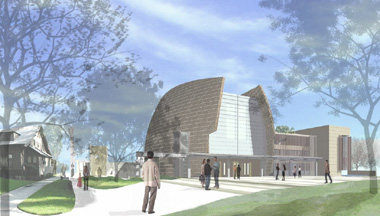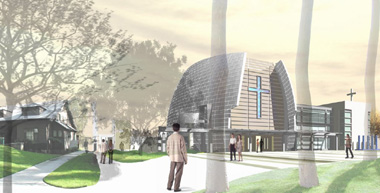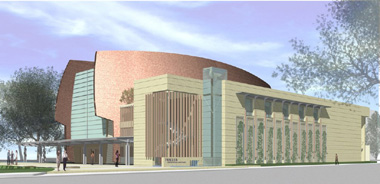Why are you building a chapel when you've managed to do without one for decades?
RICHARD J.MOUW, president, Fuller Theological Seminary: For several decades we have not had our own worshiping space and have used area churches. The problem is that the available spaces don't necessarily fit the kind of worship that students at a theological seminary are interested in.
| In Trust's editor, Jay Blossom, spoke with Fuller Theological Seminary president Richard J. Mouw about plans for a new chapel on the school's main campus in Pasadena, California. Fuller is one of North America's largest theological schools, with 4,900 students on several campuses. He also spoke separately with one of Fuller's trustees, William K. Brehm, chairman emeritus of SRA International Inc. |
When I became president in '93, I made a big point of Fuller really taking on the whole question of the arts and especially the relationship with the arts to the life and mission of the church, and the ways that the church could be more creative in its fostering of and its use of the arts in a variety of ways, including, certainly, in its own worship and life.
WILLIAM K. BREHM, trustee: It's really an outgrowth of the decision about nine or 10 years ago to create a center for worship, theology, and the arts at Fuller. My wife, Dee, and I were talking to Rich Mouw and we asked, "Why doesn't Fuller have a worship program? How do people learn how to develop a worship service?" And Rich said, "That's a really interesting idea." So he took the idea to the faculty senate, and they agreed.
 |
| (PHOTO BY WILLIAM MCDONOUGH + PARTNERS) |
MOUW: The idea grew into a center which we're calling the Brehm Center for Worship, Theology and the Arts. This center now has a $15 million endowment. We made a real commitment to providing theological guidance to the Christian community in its worshiping life in its utilization of the visual arts, music, and film.
Well, we're into this big program and we say to ourselves, we want to be a center, we want to be a real guiding light to the evangelical movement about worship and the arts, and we don't even have our own worshiping place.
BREHM: We realized that we don't have a place to practice — there's nothing in the way of facilities and technology that can really support the development of worship concepts for what amounts to about 100 different denominations represented at Fuller. We decided we need to have a chapel.
We thought that we should look beyond a chapel, more as a worship center. It encompasses an area, a feeling, an environment. As one moves from one area of the campus to another, one would say, "There's something special about this place — it's a couple of olive trees over here, a little fountain over there, and then a prayer garden over there." But in that worship center area there would also be a chapel. So that is what we have designed.
That led to the design, also, of a library that we badly needed.
We called in one of the world's finest architects — William P. McDonough — to lead us through a process where we involved the entire seminary community. We asked, "What's a chapel today? What's a chapel at Fuller? What should it look like? What are the things we want to do there?" We probably spent six months just answering those kinds of questions before pencil was put to paper.
MOUW: At the same time we were involved in campus planning, developing a master plan for the future. We're really committed to the city and we want to stay here. The Brehms, who are both major donors and visionaries in all of this, connected us with William McDonough. Their practice is to have a charrette, an intense experiment in architectural planning. We got well over 100 people in a room for a whole day, and we just sat around tables with wild ideas.
Out of that came a sense that there ought to be a chapel on the campus. A worship center that would embody the programs of the Center for Worship, Theology and the Arts, but also provide a worshiping space, a place for preaching labs, for choral practices and arrangements. And so we would have places where people could record and compose and dialogue together about church music and all of that.
The charrette really kind of gave a focus, and out of it came the plan from McDonough for this major worship center.
I guess the charrettes were the opportunity for other people to be involved too?
BREHM: The architects facilitated the meeting. Each table would develop ideas and put them on paper. Within a couple of hours, they'd report what they'd been developing and show their charts. They — students, faculty members, administrators, trustees, and visitors — would just put all these ideas together. If you looked over at a table, you couldn't tell who was who. So it was a real level playing field.
Altogether we had three charrettes. When the buildings go up, anybody who attended the charrettes can walk up to someplace on it and say, "That was my idea."
 |
| (PHOTO BY WILLIAM MCDONOUGH + PARTNERS) |
What about when you talked with the city officials and the neighbors? Were there any objections?
BREHM: The conversations in which I was involved during the charrette — people from the neighborhood were actually surprised and delighted to be there. They didn't necessarily throw in a lot of ideas but they were informed. And the same was true with the city of Pasadena. In order to get the worship center and the chapel/library projects approved, the city first has to approve a new master plan for the whole campus — another outcome of the charrette. That is working its way through the city planning system now. Once approved, then we can propose the specific structures.
How will the new library be connected to the chapel?
MOUW: The new library will face the worship center. They'll talk to each other, as it were, aesthetically — worship and study, faith and learning. They'll be connected by a plaza. So we're looking at the unity of our study, research, archival space, and our worshiping space. The south end of our campus, which has been kind of a dreary, nondescript place, will now be not only an entry point but it will be Fuller facing the center city, two blocks from city hall. We want it to be a welcoming, inviting set of integrated monuments. It's certainly going to be a witness to who we are and what we stand for.
It sounds like your commitment to the city is part of your mission.
MOUW: The seminary is located two blocks from Pasadena's magnificent city hall. We're also part of the city's arts district. And we border on residential and business neighborhoods, too. I just feel that God has placed us here for an important mission in the center of an important city. We have made a firm commitment to stay in the city. We have very close relationships with the mayor and city council people and a number of urban development organizations. That is an important part of who we are.
From what you said earlier, I gather that the chapel building is part of the worship center, which includes more than just the building?
BREHM: Yes. In addition to the chapel, there are classrooms for the preaching arts program, a choir rehearsal room, a small meditation chapel, and some administrative offices. There are gardens and there's a very unique carillon that will be outside. The worship center covers quite a lot of space, and the chapel is essentially in the center of it.
The chapel itself has to be extremely flexible. It supports learning. It also supports the chapel services for the seminary — typically a couple each week. And, of course, it has to be available for events, worship services, concerts.
You have students from so many different religious traditions. How is the new chapel going to be flexible enough to make sense to all these students?
MOUW: Not only do we have 60-plus nations but we have well over 100 denominations. All these different traditions are attracted to Fuller because it's seen as being on the cutting edge of an evangelical renewal movement. We are broadly charismatic in worship. At the same time there's a lot of interest in some of the traditional spiritual disciplines: silence, meditative prayer, contemplation, and in the sacramental life of the Christian community. In a sense we are, in our diversity, not as diverse as the actual denominational identities would suggest because we are part of a transdenominational movement.
There is a tendency in evangelicalism of a kind of bland praise worship that lacks a sense of the history of the Christian traditions and the richness of liturgical traditions. We want to make this a more educational thing where we think about ways to reintegrate the traditional hymns into worship and introduce students to the spiritual disciplines that have been developed over 2,000 years.
The classroom needs to be fed by a very practical exposure to best practices. So the worshiping life of this community — with many nations and denominations — also needs to display and draw people into best practices in worship.
How will art be incorporated into the new chapel?
MOUW: Well, obviously music and trying to make our worshiping life an exposure to the musical traditions and new music. But also working on the role of the visual and worship — evangelical worship in particular has been very audible but not very visible. So we want to see worship as being integrated with visual exploration of important themes.
What kind of students are being formed at Fuller? Especially considering how the currently used chapel space is so different from what you're going to be having, is it going to be forming a new kind of student?
BREHM: I hope so. The genesis of the whole thing was that we need to round out these students. But it's not by changing direction — I hope that we shape the students in a way that expands their abilities and interest in the arts. We have students now coming to Fuller because the Center for Worship, Theology and the Arts is there — 70 at the last count. That's quite a bit.
Are you building for growth? Or are you building for the current level of student body?
BREHM: Yes, we are building for growth, and we are building for better support. We just needed to put some energy into making facilities better at Fuller. The opportunity to do that was an outcome of the charrette process.
I'm wondering how the board of trustees works as a board, and how it's involved with the worship center?
BREHM: We have a very active board. The board gets its work done through an extensive committee structure. We have three board meetings each year, and every committee meets nearly every time there is a board meeting. There is an executive committee which meets an additional three times a year. It has certain delegated responsibilities, but beyond a certain point, everything must go to the full board. The board meets for a couple of days, so it's not just in and out in a morning. It's hard work. At the plenary session, the committee chairs report on what their committee did and put forth the resolutions they recommend be passed. It's a working board.
The trustee committee that has oversight over the worship center design, development and construction activity has been organized for three or four years. On that committee we have people represented who have experience in construction of large structures and who also know about real estate development and working with city government.
Fuller received some generous gifts and commitments, principally from the trustees, who came forward and said they were willing to commit to help make this a reality.
When do you see this process wrapping up? In terms of the building and the library and all — the chapel and the library — how many more years are we talking until it's finished?
BREHM: It's paced by two things. One is the city's approval of the master plan, and secondly, the approval of specific buildings — probably the library, the chapel, and worship center. We are working very hard on closing the gap on our fundraising. I'd like to think we can break ground in six months. We are working toward it, and we've got a very good start.
 |
| (PHOTO BY WILLIAM MCDONOUGH + PARTNERS) |